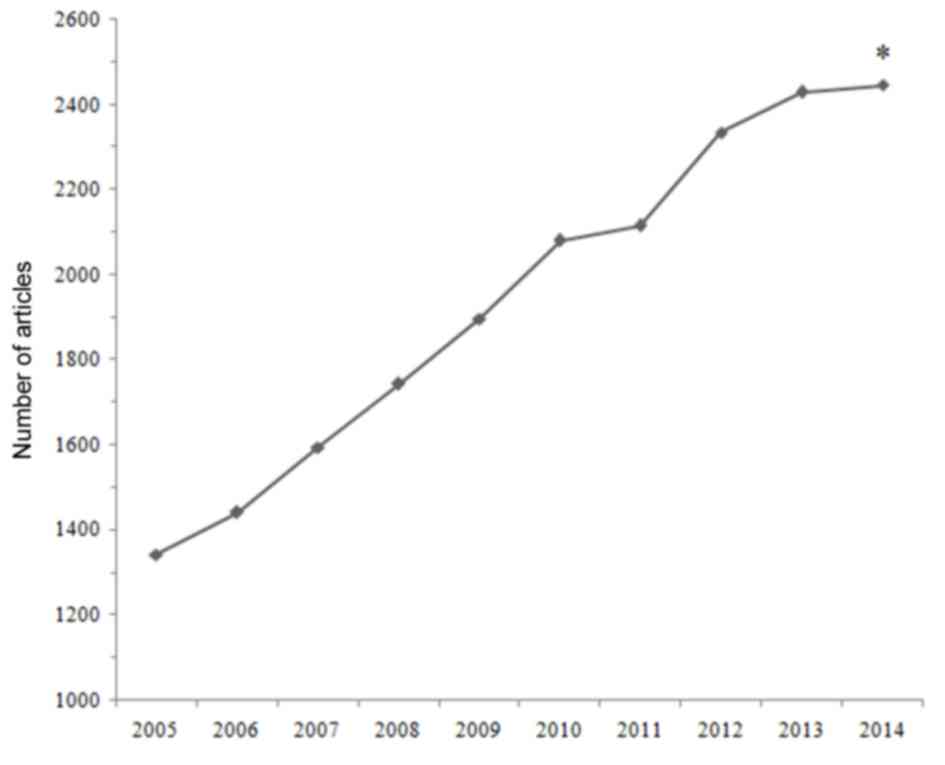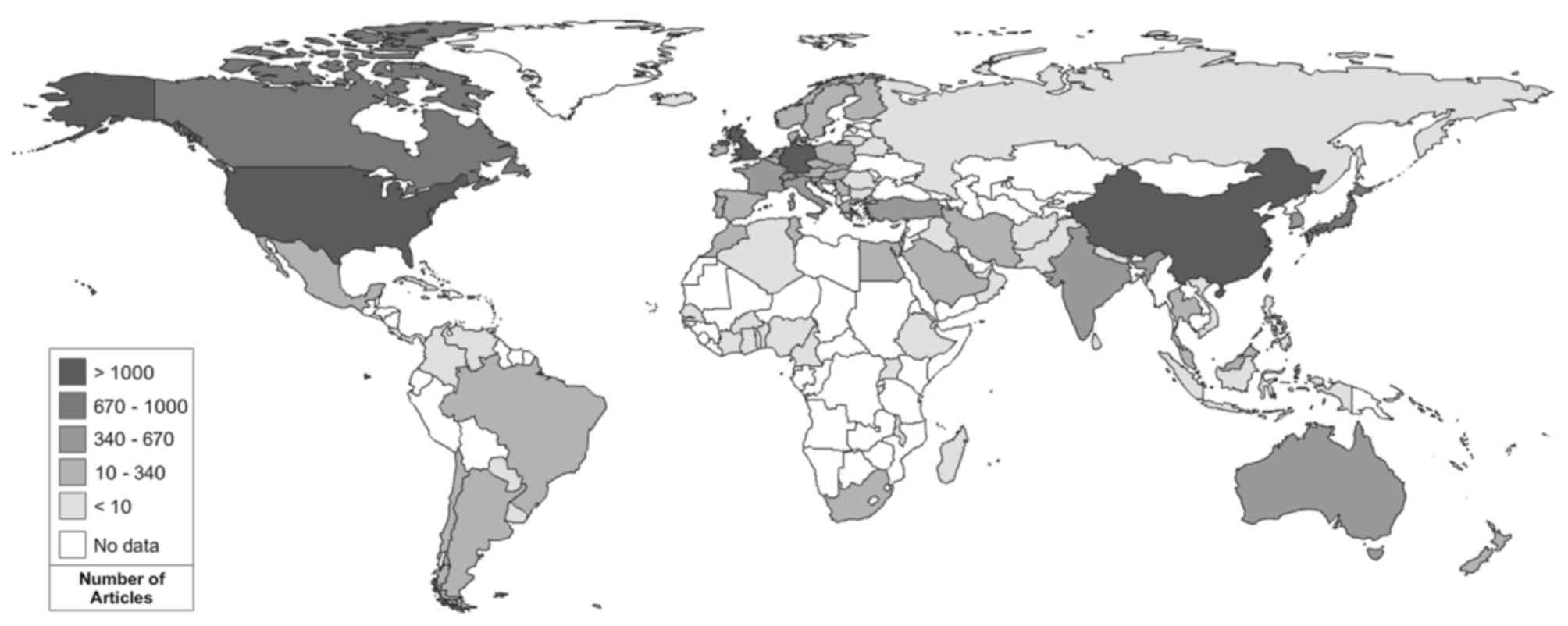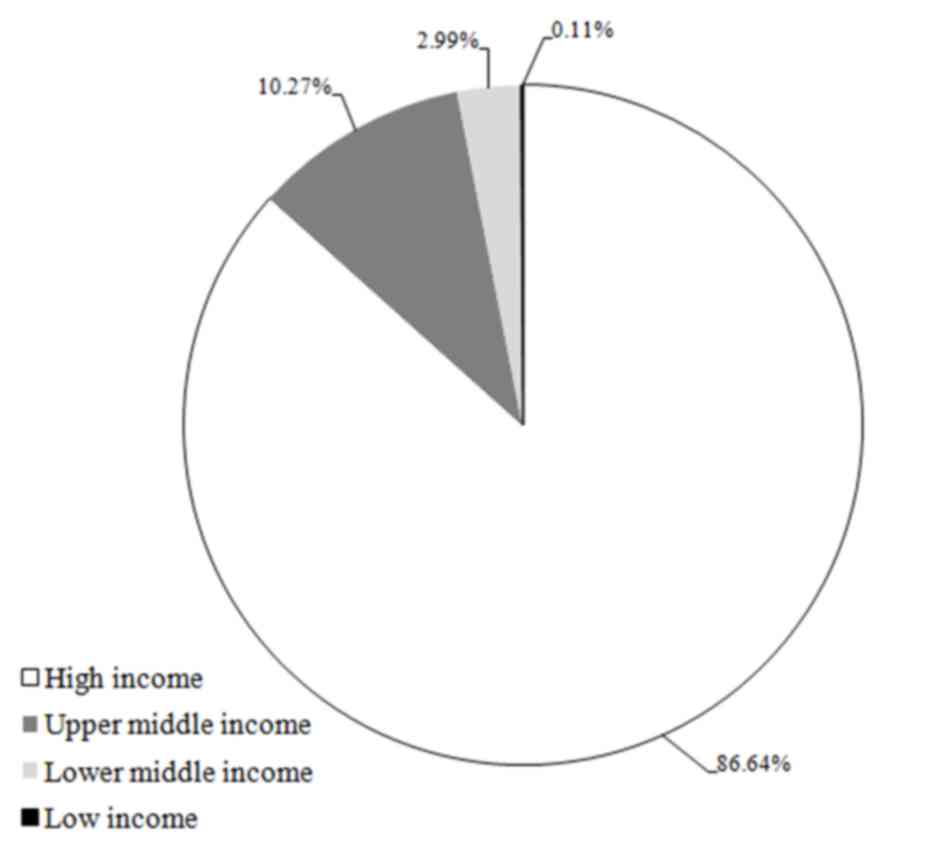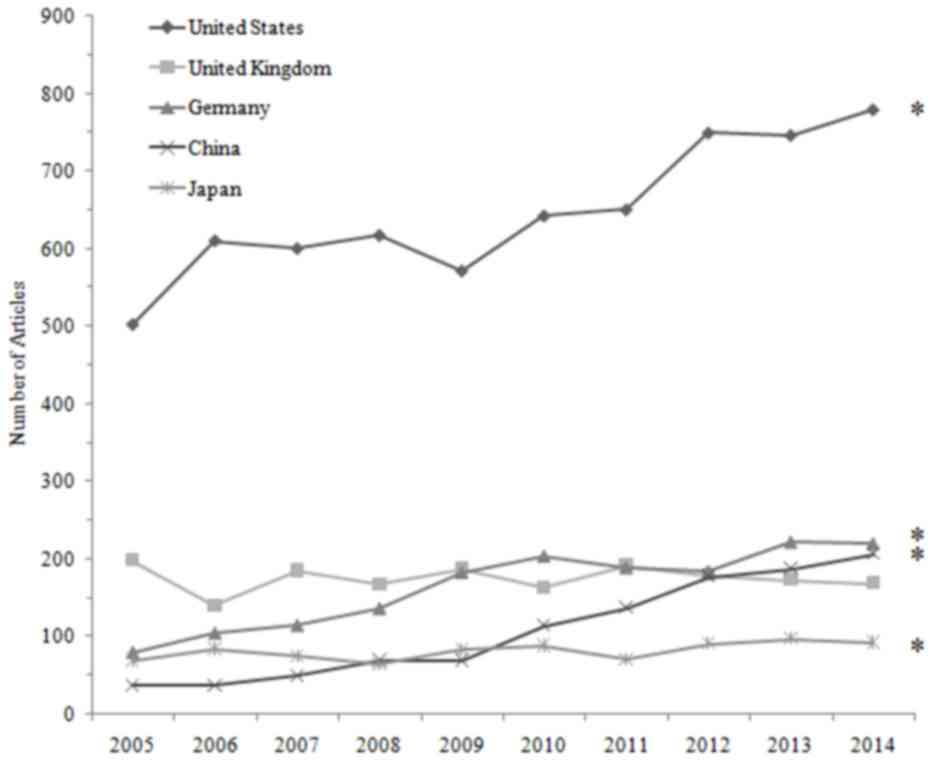Worldwide research productivity in fracture surgery: A 10-year survey of publication activity
- Authors:
- Published online on: June 13, 2017 https://doi.org/10.3892/etm.2017.4585
- Pages: 1260-1264
Abstract
Introduction
Progress has recently been observed in the field of fracture surgery, such as the rapid development of minimally invasive surgery and complex fracture management (1–3). These improvements can largely be attributed to research contributions from researchers and surgeons around the world. However, the quantity of research contributions varies between different countries, due to differences in economies, healthcare systems and medical research status (4).
The recent progress in fracture surgery may be attributed to the development of scientific research. Publishing articles is a key aspect of scientific research activities, which helps to share new knowledge worldwide (5–10). Analysis of research productivity is conducted to assess contributions to research and to analyze trends in academic publications (5–10). Recently, a number of surveys of publication activity have been conducted to evaluate the contributions of different countries in various fields of medicine, including hand and wrist surgery (5), foot and ankle reasearch (6), arthroscopic surgery (7), rheumatic disease (8), endocrinology and metabolism (9) and emergency medicine (10). These articles investigated the quantity and quality of the articles published in their fields in recent years, provided the main characteristics of the research contributions from different countries, and analyzed the potential reasons underlying these trends (5–10). Moreover, these studies give an overview of current research in certain fields, and help the surgeons and researchers to know the worldwide status of scientific productivity in their fields (5–10).
To the best of our knowledge, no previous studies have reviewed global scientific productivity in the field of fracture surgery. The present study aimed to analyze the quantity and quality of worldwide publications, in order to determine the current status of global scientific output in fracture research between 2005 and 2014.
Materials and methods
Literature search
The present study was conducted according to the design of previous studies (5–10). On August 5, 2015, a search of the Web of Science (WoS) database (www.webofknowledge.com) was conducted to identify papers published on the topic of fracture surgery. The WoS is a worldwide database that may be used for citation analysis and to obtain academic information, and has been widely used in previous publication activity studies (5–7). A total of 72 journals were in the ‘Orthopedics’ category of the 2014 Journal Citation Reports in the WoS, and were all included in the current study. All papers published between January 2005 and December 2014 in the 72 journals were searched, with no restriction on language, and ‘fractur’ was used as a search term to identify relevant publications (7). Original papers and reviews were included, while letters, editorials and corrections were excluded.
Data collection
The literature search, paper selection and data collection was conducted by two independent authors. Any disagreements on paper selection were resolved by discussion, and a third author was referred to for the final decision when necessary. The quantity and quality of scientific output was evaluated according to the number of publications and citations, respectively (5–7). The nation in the correspondence address was used to determine the source nation (5–7). The nations were assorted into high-, upper-middle-, lower-middle- and low-income countries in terms of Gross National Income per capita according to the World Bank database (http://data.worldbank.org). High-, upper-middle, lower-middle and low-income were defined as ≥$12,736, $4,126–12,735, $1,046–4,125 and ≤$1,045, respectively.
Countries producing ≥1% of the global publications were defined as the main prolific countries (5–7). Populations of each country were identified using the Central Intelligence Agency records (https://www.cia.gov/library/publications/the-world-factbook). Based on the numbers of fracture articles, the five leading journals in each of the five leading nations and the top five nations in each of the five leading journals were analyzed.
Statistical analysis
Significant changes in publication numbers over the time period investigated were determined using regression analysis. SPSS 19.0 software (IBM SPS, Armonk, NY, USA) was used for statistical analysis and P<0.05 was considered to indicate a statistically significant difference.
Results
Worldwide production
A total of 19,423 fracture papers were identified in WoS between 2005 and 2014. A significant increase was observed in the number of yearly papers during the study period (P<0.001; Fig. 1), with 1,342 papers published in 2005 and 2,446 papers published in 2014. Thus, there was a 1.82-fold increase in the number of published papers from 2005 to 2014.
The fracture articles identified were published by 86 nations. The world map in Fig. 2 exhibits the global scientific output. A total of 16,828 papers (86.64%) were from high-income countries and 2,574 papers (13.25%) were from upper-middle and lower-middle income countries. Low-income countries produced only 21 papers (0.11%; Fig. 3).
The top three productive areas were North America, West Europe and East Asia. The United States contributed the highest number of publications in fracture surgery (6,476; 33.34%), followed by the United Kingdom (1,754; 9.03%), Germany (1,635; 8.42%), China (1,083; 5.58%) and Japan (812; 4.18%; Table I). The trends in article publications over time from these top 5 countries are depicted in Fig. 4. All 5 countries exhibited significant increases in the number of article publications from 2005 to 2014 (P<0.05), excluding the United Kingdom (P=0.976). China exhibited the greatest increase in publications from 2005 (37 papers) to 2014 (206 papers; 5.57-fold increase). Therefore, China moved from the fifth most productive country in 2005 to the third most productive by 2014, and exceeded Japan and the United Kingdom and narrowed the margin with Germany in doing so.
Main prolific nations
There were 18 main prolific nations (publishing ≥1% of overall papers; Table I). The majority of these countries (15/18) were high-income nations, while the remaining 3 nations, namely China, Turkey and India, were middle-income nations. The 18 main prolific countries published the majority of papers (90.19%; 17,517/19,423). Papers produced by the United States exhibited the highest overall citations (72,640). Upon calculating average citations, Sweden ranked first (15.63), followed by Australia (12.84) and Canada (12.44). Upon calculating the per capita output of the number of publications, Switzerland ranked first (56.39), followed by Austria (35.43) and the Netherlands (30.68).
Top five journals in the top five countries
Table II displays the top five journals based on fracture surgery publications in each of the top five nations. Journal of Orthopedic Trauma (JOT), Injury, Zeitschrift fur Orthopadie und Unfallchirurgie (ZOU), International Orthopedics (IO), Journal of Orthopedic Science were the most prevalent journals in the United States, the United Kingdom, Germany, China and Japan, respectively. In addition, Injury, IO and AOTS were among the top five journals in three of the five leading nations.
Top five countries in the top five journals
The top five journals based on the number of published papers were Injury (1,714; 8.82%), JOT(1,302; 6.70%), CORR(985; 5.07%), Journal of Bone and Joint Surgery-American Volume (JBJS Am) (968; 4.98%) and AOTS (793; 4.08%). Table III lists the top five nations in each of the five leading journals. The United States was the most productive nation in three of the journals, namely JOT, CORR and JBJS Am, while the United Kingdom was the most prolific nation in Injury and Germany was the most prolific nation in AOTS. Furthermore, the United States, United Kingdom and Germany were among the top five nations in four of the top five journals.
Discussion
Fracture surgery has notably improved in recent years due to the contributions of global research (1–3). Scientific papers aid in the dissemination of novel findings, and indicate the research output of each country. The present study identified a significant increase in the number of fracture articles published from 2005 to 2014. The United States had produced the most articles in the field of fracture surgery worldwide. This potentially indicates the impact of research from the United States on developments in fracture surgery.
In addition to the highest quantity of fracture articles, the United States exhibited the highest overall citations and high mean citations per article, which suggests a high production and research output of high-quality papers from the United States. In addition, the United States produced a high per capita number of publications, which indicated that the United States was the leading prolific nation in fracture surgery worldwide.
Previous studies have documented that the ratio of research publications between non-high and high-income countries was 10:90 (11). This result had been documented in multiple fields (5–7,9,10). The present study identified a similar ratio (13:87). Three middle-income countries (China, Turkey and India) were among the main prolific countries. These countries have made increasing contributions in numerous medical fields (5–7), and their greater research output may be attributed to economic improvement. However, only 21 papers were published by low-income countries. Low productivity in low-income countries may be attributed to their political policies, healthcare systems, funding resources and availability of researchers (6,7,11).
A number of small countries in Europe, including Switzerland, Austria and the Netherlands, were more prolific when paper output was adjusted for population size. It may have been more accurate to adjust the research output based on the overall number of researchers in fracture surgery in each country; however, obtaining such data is difficult. Regardless, the present findings suggest that these smaller nations in Europe achieved high-level research production. In addition, when using mean citation values to assess the quality of publications, Sweden ranked first. The production of high quality publications from smaller European countries may be due to the following reasons: i) European researchers typically submit their studies to domestic journals, and only outstanding research is likely to be submitted to high impact journals (12), ii) language barriers require European research to be of higher quality (7,12) and iii) higher quality resources may improve research quality (13).
The United States was most productive in three of the top five journals, namely JOT, CORR, JBJS Am. Germany was the most productive country in AOTS, and ZOU, DO and AOTS were the 3 most productive journals in Germany. However, all of these journals were located in the associated country, and thus more submissions may have been from these countries than from other countries.
There were several limitations in the present study. For instance, only WoS was used to search for fracture articles, meaning papers published in journals that were not included in WoS were excluded, which potentially excluded numerous fracture articles. It was also difficult to distinguish articles that centered on fracture surgery from those that only mentioned the term or tangentially addressed it. Despite these limitations, the broad and large-sample analysis conducted in the present study successfully indicated overall research productivity in fracture surgery, which may be used to track the main trends and identify topics of interest.
In conclusion, there was marked progress in the quantity of publications in fracture surgery from 2005 to 2014. The majority of fracture papers were produced by high-income nations, while few papers were produced by low-income nations. The United States was the leading prolific nation, though several smaller nations in Europe may be more prolific when adjusted for population size.
Acknowledgements
The present study was supported by the Young Medical Talents Training Program of Shanghai Baoshan District, China (grant no. bswsyq-2014-A03).
References
|
Teague DC, Erti WJ, Hickerson L and Roberts Z: What's new in orthopaedic trauma. J Bone Joint Surg Am. 98:1142–1149. 2016. View Article : Google Scholar : PubMed/NCBI | |
|
Piétu G and Ehlinger M: Minimal invasive internal fixation of distal femur fractures. Orthop Traumatol Surg Res. 103(1S): S161–S169. 2017. View Article : Google Scholar : PubMed/NCBI | |
|
Kokkalis ZT, lliopoulos ID, Pantazis C and Panagiotopoulos E: What's new in the management of complex tibial plateau fractures? Injury. 47:1162–1169. 2016. View Article : Google Scholar : PubMed/NCBI | |
|
Langer A, Diaz-Olavarrieta C, Berdichevsky K and Villar J: Why is research from developing countries underrepresented in international health literature, and what can be done about it? Bull World Health Organ. 82:802–803. 2004.PubMed/NCBI | |
|
Mei X, Zhu X, Zhang T, Jia Z and Wang C: Worldwide productivity in the hand and wrist literature: A bibliometric analysis of four highly cited subspecicalty journals. Int J Surg. 28:8–12. 2016. View Article : Google Scholar : PubMed/NCBI | |
|
Luo X, Liang Z, Gong F, Bao H, Huang L and Jia Z: Worldwide productivity in the field of foot and ankle research from 2009–2013: A bibliometric analysis of highly cited journals. J Foot Ankle Res. 8:122015. View Article : Google Scholar : PubMed/NCBI | |
|
Liang Z, Luo X, Gong F, Bao H, Qian H, Jia Z and Li G: Worldwide research productivity in the field of arthroscopy: A bibliometric analysis. Arthroscopy. 31:1452–1457. 2015. View Article : Google Scholar : PubMed/NCBI | |
|
Cheng T and Zhang G: Worldwide research productivity in the field of rheumatology from 1996 to 2010: A bibliometric analysis. Rheumatology (Oxford). 52:1630–1634. 2013. View Article : Google Scholar : PubMed/NCBI | |
|
Zhao X, Ye R, Zhao L, Lin Y, Huang W, He X, Lian F and Tong X: Worldwide research productivity in the field of endocrinology and metabolism-a bibliometric analysis. Endokrynol Pol. 66:434–442. 2015. View Article : Google Scholar : PubMed/NCBI | |
|
Li Q, Jiang Y and Zhang M: National representation in the emergency medicine literature: A bibliometric analysis of highly cited journals. Am J Emerg Med. 30:1530–1534. 2012. View Article : Google Scholar : PubMed/NCBI | |
|
Saxena S, Paraje G, Sharan P, Karam G and Sadana R: The 10/90 divide in mental health research: Trends over a 10-year period. Br J Psychiatry. 188:81–82. 2006. View Article : Google Scholar : PubMed/NCBI | |
|
Akre O, Barone-Adesi F, Pettersson A, Pearce N, Merletti F and Richiardi L: Differences in citation rates by country of origin for papers published in top-ranked medical journals: Do they reflect inequalities in access to publication? J Epidemiol Community Health. 65:119–123. 2011. View Article : Google Scholar : PubMed/NCBI | |
|
King DA: The scientific impact of nations. Nature. 430:311–316. 2004. View Article : Google Scholar : PubMed/NCBI |













